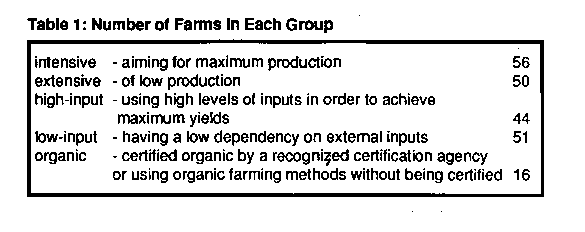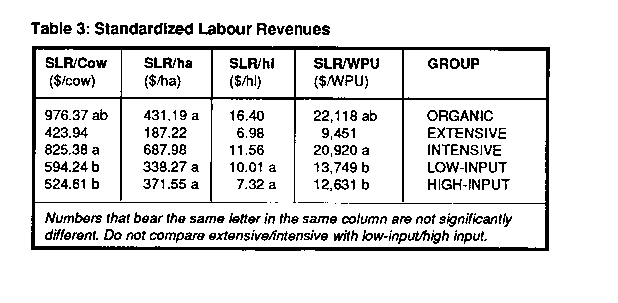
Sustainable Farming Index | Virtual Library | Magazine Rack
Search
| Ecological Solutions Roundtable
by Daniel Burgayne & Raymond Levallois
Efforts to maximize production without taking into account the environment and the health of livestock leads to the depletion of resources in any production system. This conclusion, arrived at by other researchers, prompted this examination of alternative farming systems for possible solutions to the problem.
In order to make an objective evaluation of some of the alternatives, revenues of the alternative systems must be compared with that of conventional intensive and high-input farming systems. This article summarizes a study done to compare the profitability of different milk production systems in Quebec.
The data indicates that organic farming can produce a better financial performance in comparison with the other groups: intensive conventional farming, high input, extensive and low input. The organic farms draw their comparative advantage from lower costs of production, while having milk yields that compare favorably.
The intensive farms have better financial results than the extensive farms because they seem to optimize the factors of production. The high-input farms do not obtain better financial results than the low-input farms. Although the high-input farms obtain much higher yields than the low-input farms, their costs of production are higher, negating the effect of the higher yields.
Other variables were analyzed -price received for the milk, assets per cow (buildings and machinery only), total liabilities per cow and per hectolitre, cow replacement rate, number of cows per work person unit (WPU) and number of years in school - but no differences were found between the groups.
The first conclusion that can be made is that the organic farming systems studied are as profitable, if not more so, than the conventional farming systems having the best standardized labour revenue (SLR) values.
Secondly, all groups seemed to have the same production structure. It would then appear that the best of two worlds could be combined - high milk yields with low costs for external inputs.
A possible limitation of this study is the difficulty associated with trying to measure the management capabilities of the owners. The organic farmers probably have higher management skills that would give them a greater ability to adapt to changing situations. The study, however, does not permit us to derive any scientific conclusions on this.
Another possible limitation could be the relatively small number of organic milk farms for which data was available in 1989. This study could be done again a few years down the road when there will probably be more organic dairy farms.
Furthermore, at this point we do not know what the cost is to society of having farms that are input intensive and have a greater potential to pollute rivers, etc., especially when they are not more profitable than low-input and organic farms that are supposedly less polluting. The long term environmental costs of this component needs to be evaluated.
Farms were classified into five different groups (Table 1). 1989 statistics on Quebec dairy farms were obtained from the Fédération des syndicate de gestion agricole du Québec (a federation of farm management groups).

In order to limit the comparison to farms specializing in milk production, data from a conventional farm was used if the proportion of its gross revenue from milk sales exceeded 85% of the farm's total gross revenue. Statistics from an organic farm were selected if the farm was certified organic by a recognized certification agency or if organic farming techniques were practiced without being officially certified. In the organic group, the average proportion of the farm's gross revenue attributed to milk sales was 82%. The 366 farms selected were all members of a farm management group.
As well as being classified by production type, data pertaining to milk production, to cropping practices and to the farm's management as a whole were analyzed separately. Results from the whole farm analysis are presented here. The intensive group had milk production per hectare well above the average of the 366 farms, while the extensive f arms were well be low. This criterion is a good measure of the level of intensity of production since it represents the milk and forage yield at the same time.
The high-input group was well above the average of the 366 farms with respect to the composite of the number of kilograms of protein in the concentrate served to the cows, and the input costs per hectare. In contrast, the low-input group was well below the average of this last criterion. This composite criterion is a good indicator of the level of inputs used for milk and crop production at the same time.
Table 2 shows the profiles of the farms studied. The results of the organic group can be compared to any other group. It is considered as the control group against which the other groups were tested. The intensive group can be compared with the extensive, and the high-input group with the low-input: they are part of the same treatment.

The first column shows the average year in which each group first became a member of a farm management group (SGA). The two subsequent columns show the number of farm and total family working person units (WPU). A WPU is a person, owner or employee, who works on the farm 3,000 hours per year. The other columns show the number of cows and litres of milk produced.
The organic group is fairly similar to the other groups with respect to the number of cows, milk production, WPU and the first year of membership to a SGA.
Table 3 presents a summary of economic variables that evaluate the profitability of the groups studied. The Standardized Labour Revenue (SLR) is a relative measure of revenue that permits comparison of farms with different levels of debt. The SLRs per cow, per hectare, per hectolitre and per WPU measure the technical efficiency per unit produced or by factor of production. The SLR per WPU is usually used to compare the revenue between farms, as H is a good indicator of the revenue per working person. This is useful to see if the farm can generate enough money to remunerate everybody who works on it.

Copyright © 1992 REAP Canada.
Reprinted with permission. All rights reserved.
Info Request | Services | Become EAP Member | Site Map
Give us your comments about the EAP site
Ecological Agriculture Projects, McGill University (Macdonald
Campus),
Ste-Anne-de-Bellevue, QC, H9X 3V9 Canada
Telephone:
(514)-398-7771
Fax:
(514)-398-7621
Email: info@eap.mcgill.ca
To report problems or otherwise comment on the structure of this site, send mail to the Webmaster